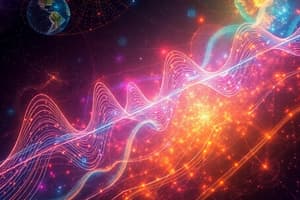Podcast
Questions and Answers
The process of breaking up food particles and initiating spoken language occurs in the ______.
The process of breaking up food particles and initiating spoken language occurs in the ______.
mouth
Saliva, produced by the ______, moistens and lubricates food, while also initiating the digestion of polysaccharides through amylase.
Saliva, produced by the ______, moistens and lubricates food, while also initiating the digestion of polysaccharides through amylase.
salivary glands
The ______ is responsible for swallowing food, acting as a crucial passage for ingested material.
The ______ is responsible for swallowing food, acting as a crucial passage for ingested material.
pharynx
As a key component of the digestive system, the ______ transports food from the pharynx to the stomach.
As a key component of the digestive system, the ______ transports food from the pharynx to the stomach.
The ______ plays a crucial role in digestion by storing and churning food, using pepsin to digest protein, and employing hydrochloric acid to activate enzymes and kill germs.
The ______ plays a crucial role in digestion by storing and churning food, using pepsin to digest protein, and employing hydrochloric acid to activate enzymes and kill germs.
Bile, which aids in digestion, is stored and concentrated in the ______.
Bile, which aids in digestion, is stored and concentrated in the ______.
Located in the digestive system, the ______ completes digestion, absorbs nutrients and water, digests proteins and sugars, and digests polysaccharides.
Located in the digestive system, the ______ completes digestion, absorbs nutrients and water, digests proteins and sugars, and digests polysaccharides.
The ______ is responsible for reabsorbing water and ions, as well as forming and storing feces.
The ______ is responsible for reabsorbing water and ions, as well as forming and storing feces.
The ______ stores and expels feces as part of the digestive elimination process.
The ______ stores and expels feces as part of the digestive elimination process.
The opening for the elimination of feces is the ______.
The opening for the elimination of feces is the ______.
The ______ helps regulate blood glucose levels, neutralize stomach acid, digest proteins and polysaccharides, and digest lipids.
The ______ helps regulate blood glucose levels, neutralize stomach acid, digest proteins and polysaccharides, and digest lipids.
The ______ breaks down and builds up many biological molecules, stores vitamins and iron, destroys old blood cells and poisons, and helps with bile production.
The ______ breaks down and builds up many biological molecules, stores vitamins and iron, destroys old blood cells and poisons, and helps with bile production.
The enzyme ______, secreted in the stomach, is responsible for the digestion of proteins into smaller peptides.
The enzyme ______, secreted in the stomach, is responsible for the digestion of proteins into smaller peptides.
______ is secreted by the pancreas to neutralize the acidic chyme entering the small intestine from the stomach.
______ is secreted by the pancreas to neutralize the acidic chyme entering the small intestine from the stomach.
______ produced by the salivary glands, is responsible for beginning the digestion of polysaccharides in the mouth.
______ produced by the salivary glands, is responsible for beginning the digestion of polysaccharides in the mouth.
The primary function of the ______ in the stomach is to protect the stomach wall from the corrosive effects of hydrochloric acid.
The primary function of the ______ in the stomach is to protect the stomach wall from the corrosive effects of hydrochloric acid.
The hormone-producing function of the pancreas helps to regulate ______ levels in the blood, maintaining metabolic balance.
The hormone-producing function of the pancreas helps to regulate ______ levels in the blood, maintaining metabolic balance.
The ______ present in the small intestine are responsible for the final digestion of sugars into monosaccharides.
The ______ present in the small intestine are responsible for the final digestion of sugars into monosaccharides.
The ______ enzymes from the pancreas are crucial for breaking down dietary lipids into fatty acids and glycerol.
The ______ enzymes from the pancreas are crucial for breaking down dietary lipids into fatty acids and glycerol.
The enzyme ______, produced by the pancreas, aids in the digestion of proteins in the small intestine.
The enzyme ______, produced by the pancreas, aids in the digestion of proteins in the small intestine.
Flashcards
Mouth
Mouth
Breaks up food particles and assists in producing spoken language.
Salivary Glands
Salivary Glands
Saliva moistens and lubricates food, while amylase digests polysaccharides.
Pharynx
Pharynx
This part of the digestive system swallows food.
Esophagus
Esophagus
Signup and view all the flashcards
Liver
Liver
Signup and view all the flashcards
Gallbladder
Gallbladder
Signup and view all the flashcards
Stomach
Stomach
Signup and view all the flashcards
Pancreas
Pancreas
Signup and view all the flashcards
Small Intestine
Small Intestine
Signup and view all the flashcards
Large Intestine
Large Intestine
Signup and view all the flashcards
Anus
Anus
Signup and view all the flashcards
Rectum
Rectum
Signup and view all the flashcards
Study Notes
- The Laplace Transform of a function $f(t)$ defined for $t \ge 0$ is given by the integral $F(s) = \int_{0}^{\infty} e^{-st} f(t) dt$, provided the integral converges.
- $F(s)$ is the notation for the Laplace Transform of $f(t)$, written as $F(s) = L{f(t)}$.
- The Laplace Transform changes a function of $t$ into a function of $s$.
- Only values of $t \ge 0$ are considered.
Example Laplace Transforms
- $L{1} = \frac{1}{s}$ for $s > 0$.
- $L{e^{at}} = \frac{1}{s-a}$ for $s > a$.
- $L{sin(at)} = \frac{a}{s^{2} + a^{2}}$ for $s > 0$.
Laplace Transforms Table
- For $f(t) = 1$, $F(s) = \frac{1}{s}$ where $s > 0$.
- For $f(t) = e^{at}$, $F(s) = \frac{1}{s-a}$ where $s > a$.
- For $f(t) = sin(at)$, $F(s) = \frac{a}{s^{2} + a^{2}}$ where $s > 0$.
Studying That Suits You
Use AI to generate personalized quizzes and flashcards to suit your learning preferences.




